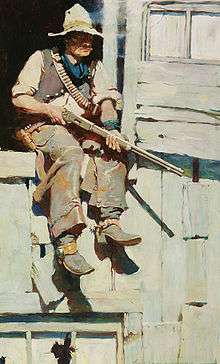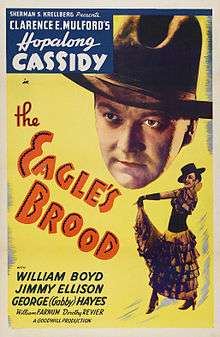Hopalong Cassidy

Hopalong Cassidy or Hop-along Cassidy is a fictional cowboy hero created in 1904 by the author Clarence E. Mulford, who wrote a series of popular short stories and many novels based on the character.
In his early writings, Mulford portrayed the character as rude, dangerous, and rough-talking. He had a wooden leg which caused him to walk with a little "hop", hence the nickname. From 1935, the character—as played by movie actor William Boyd in films adapted from Mulford's books—was transformed into a clean-cut, sarsparilla-drinking hero. Sixty-six popular films appeared, only a few of which were loosely based on Mulford's stories.
Film history

As portrayed on the screen, white-haired Bill "Hopalong" Cassidy was usually clad strikingly in black (including his hat, an exception to the western film stereotype that only villains wore black hats). He was reserved and well spoken, with a sense of fair play. He was often called upon to intercede when dishonest characters took advantage of honest citizens. "Hoppy" and his white horse, Topper, usually traveled through the west with two companions—one young and trouble-prone with a weakness for damsels in distress, the other older, comically awkward and outspoken.[1]
The juvenile lead was successively played by James Ellison, Russell Hayden, George Reeves, Rand Brooks and Jimmy Rogers.[2] George Hayes (later to become known as "Gabby" Hayes) originally played Cassidy's grizzled sidekick, Windy Halliday. After Hayes left the series because of a salary dispute with producer Harry Sherman, he was replaced by the comedian Britt Wood as Speedy McGinnis and finally by the veteran movie comedian Andy Clyde as California Carlson. Clyde, the most durable of the sidekicks, remained with the series until it ended. A few actors of future prominence appeared in Cassidy films, notably Robert Mitchum, who appeared in seven films at the beginning of his career.
The 66 Hopalong Cassidy pictures were filmed by independent producers who released the films through the studios. The first "Hoppies," as the films were known, were distributed by Paramount Pictures to favorable returns, and United Artists was the distributor after Paramount. They were noted for fast action and outdoor photography (usually by Russell Harlan). Harry Sherman wanted to make more ambitious movies and tried to cancel the Cassidy series, but popular demand forced Sherman back into production, this time for United Artists. Sherman gave up the series in 1944, but William Boyd wanted to keep it going. To do this, he gambled his future on Hopalong Cassidy, mortgaging most of what he owned to buy the character rights from Mulford and the backlog of movies from Sherman.
In the first film, Hopalong Cassidy (then spelled "Hop-along") got his name after being shot in the leg. Hopalong's "drink of choice" was the nonalcoholic sarsaparilla.
Television and radio
.png)
Boyd resumed production[3] in 1946, on lower budgets, and continued through 1948, when "B" westerns were being phased out. Boyd thought Hopalong Cassidy might have a future in television, spent $350,000 to obtain the rights to his old films,[3] and approached the fledgling NBC network. The initial broadcasts were so successful that NBC could not wait for a television series to be produced and edited the feature films to broadcast length.[4] On June 24, 1949, Hopalong Cassidy became the first network Western television series.
The success of the television series made Boyd a star.[3] The Mutual Broadcasting System began broadcasting a radio version, with Andy Clyde (later George MacMichael on Walter Brennan's ABC sitcom The Real McCoys) as the sidekick, in January 1950; at the end of September, the show moved to CBS Radio, where it ran until 1952.[5]
The series and character were so popular that Hopalong Cassidy was featured on the cover of national magazines such as Look, Life, and Time.[3] Boyd earned millions as Hopalong ($800,000 in 1950 alone),[3] mostly from merchandise licensing and endorsement deals. In 1950, Hopalong Cassidy was featured on the first lunchbox to bear an image, causing sales for Aladdin Industries to jump from 50,000 to 600,000 in one year. In stores, more than 100 companies in 1950 manufactured $70 million of Hopalong Cassidy products,[3] including children's dinnerware, pillows, roller skates, soap, wristwatches, and jackknives.[6]
There was a new demand for Hopalong Cassidy features in movie theaters, and Boyd licensed reissue distributor Film Classics to make new film prints and advertising accessories. Another 1950 enterprise saw the home-movie company Castle Films manufacturing condensed versions of the Paramount films for 16 mm and 8 mm film projectors; they were sold through 1966. Also, in January 1950 Dan Spiegel began to draw a syndicated comic strip with scripts by Royal King Cole; the strip lasted until 1955.[7][8]
Boyd began work on a separate series of half-hour westerns made for television; Edgar Buchanan was his new sidekick, Red Connors (a character from the original stories and a few of the early films). The theme music for the television show was written by Nacio Herb Brown (music) and L. Wolfe Gilbert (lyrics). The show ranked number 7 in the 1949 Nielsen ratings, number 9 in the 1950-1951 season and number 28 in 1951-1952.[9] The success of the show and tie-ins inspired juvenile television westerns such as The Range Rider, Tales of the Texas Rangers, Annie Oakley, The Gene Autry Show, and The Roy Rogers Show.
After Boyd's death, his company devoted to Hopalong Cassidy, U.S. Television Office, retained control of Cassidy films but, by the mid-1960s, had withdrawn them from television and sales in home movie markets. This remained the situation until the mid-1990s, after many Cassidy fans had died, when the company made available to The Western Channel a package series of restored and cleaned negative-based prints of the films to cable TV. These remained available on that channel until 2000, when they were again withdrawn. Minimal effort was made at that time, nor has it been made since, to offer the films for home video, excepting two packages of compressed, multi-title Hopalong Cassidy anthology DVDs, the first requiring purchase of the entire TV series to obtain copies of about a dozen films and then, in 2014, a reissue of the remaining stock of these same DVD pressings combined with the remaining titles in a first-time pressing.
The TV series can be currently seen on Cozi TV.[10]
Hoppyland
On May 26, 1951, an amusement park named Hoppyland opened in the Venice section of Los Angeles. This was an expansion and retheming of Venice Lake Park[11] (opened the previous year) as Boyd became an investor. Standing on some 80 acres (320,000 m2) it included a roller coaster, miniature railroads, pony rides, boat ride, Ferris wheel, carousel, and other thrill rides along with picnic grounds and recreational facilities. Despite Boyd's regular appearances as Hoppy at the park, it was not a success and shut down in 1954.[12]
In other media
Novels
Louis L'Amour wrote four Hopalong Cassidy novels, which are still in print. In 2005, author Susie Coffman published Follow Your Stars, new stories starring the character. In three of these stories, Coffman wrote the wife of actor William Boyd into the stories.
Comic books/comics strips
Fawcett Comics published a Hopalong Cassidy comic book one-shot in 1943,[13] followed by an ongoing series from 1946–1953,[14] when the company ceased publishing. DC Comics took over the title in 1954 with issue #86,[15] publishing it until issue #135, in 1959.[16]
Mirror Enterprises Syndicate distributed a Hopalong Cassidy comic strip starting in 1949; it was bought out by King Features in 1951, running until 1955. The strip was drawn by Dan Spiegle.
Record readers
Beginning in 1950, Capitol Records released a series of Hopalong Cassidy "record readers" featuring William Boyd and music by Billy May, produced by Alan W. Livingston.[17]
Music
The song "It's Beginning To Look A Lot Like Christmas" includes a reference to Hopalong boots as a holiday gift desired by children.
Museums
There have been museum displays of Hopalong Cassidy. The major display is at the Autry National Center at Griffith Park in Los Angeles, California. Fifteen miles east of Wichita, Kansas, at the Prairie Rose Chuckwagon Supper was the Hopalong Cassidy Museum. The museum and its contents were auctioned on August 24, 2007, owing to the failure of its parent company, Wild West World.
A "Hoppy Museum" consisting of a collection of products endorsed by William Boyd is located at Scott's 10th Street Antique Mall in Cambridge, Ohio.[18]
US Post
In 2009 the US Postal Services selected Cassidy as one of the characters featured on a series of stamps depicting early TV characters.[19]
DVD release
On June 16, 2009, Echo Bridge Home Entertainment released the Hopalong Cassidy Ultimate Collector's Edition, which included all 66 theatrical films on 14 DVDs, packed into a facsimile Hopalong Cassidy tin lunchbox.
On June 7, 2011, Timeless Media Group released Hopalong Cassidy: The Complete Television Series on DVD in Region 1.[20] The 6-disc set features all 52 episodes of the series restored and remastered.
See also
References
- ↑ "William Boyd & Hopalong Cassidy", B-Westerns
- ↑ New York Times
- 1 2 3 4 5 6 "Kiddies in the Old Corral" Time, 27 November 1950.
- ↑ "TV ACRES: Broadcast Firsts > Western Series". Tvacres.com. Retrieved 6 December 2014.
- ↑ Radio Broadcast Log Of: Hopalong Cassidy part of Audio Classics Archive. Retrieved 2006-12-09.
- ↑ Westerns – Museum of Broadcast Communications
- ↑ Tom Hoepf. "Hopalong Cassidy Returns". Toycollectormagazine.com. Retrieved 6 December 2014.
- ↑ "Dan Spiegle". lambiek.net. Retrieved 6 December 2014.
- ↑ http://www.classictvhits.com/tvratings/index.htm
- ↑ http://www.cozitv.com/shows/weekday/Hopalong-Cassidy-251473211.html
- ↑ "Bill Boyd Will Appear at Hoppyland Opening" Billboard March 31, 1951 p.52
- ↑ "Hoppyland". Westland.net. Retrieved 6 December 2014.
- ↑ Hopalong Cassidy (1943 series) at the Grand Comics Database
- ↑ Hopalong Cassidy (1946 series) at the Grand Comics Database
- ↑ Irvine, Alex; Dolan, Hannah, ed. (2010). "1950s". DC Comics Year By Year A Visual Chronicle. Dorling Kindersley. p. 72. ISBN 978-0-7566-6742-9.
Following the decision to close the comics division of Fawcett Publications in 1953, Hopalong Cassidy came to DC with issue #86...by the writers Gardner Fox and Don Cameron and artist Gene Colan.
- ↑ Hopalong Cassidy (1954 series) at the Grand Comics Database
- ↑ Alan Livingston and The Capitol Record Readers
- ↑ "Hoppy Museum". Scott's 10th Street Antiques. Retrieved 28 April 2016.
- ↑ 1001 TV Series You Must Watch Before You Die, Paul Condon, ISBN 978-1-84403-887-9
- ↑ Archived November 2, 2011, at the Wayback Machine.
Further reading
- Caro, Joseph, Collector's Guide to Hopalong Cassidy Memorabilia (1991, out of print)
- Caro, Joseph, Hopalong Cassidy Collectibles. CCN Publishing (1998) – 1,300 color photos and item conditions
- Drew, Bernard A., The Hopalong Cassidy Radio Program. Albany: BearManor Media (2005) ISBN 1-59393-006-2
- Hall, Roger, Following the Stars: Music and Memories of Hopalong Cassidy. Stoughton: PineTree Press (2005)
- Perham, Joseph A., Reflections on Hopalong Cassidy: A Study of Clarence E. Mulford, unplublished M.A. thesis, University of Maine (1966)
- Spiegle, Dan and Royal King Cole, Paragon Publications Presents Clarence E. Mulford's Hopalong Cassidy and the Five Men of Evil. A.C. Comics (Jan. 1993) ISBN 978-1-56225-002-7 (comic strip reprint collection)
External links
| Wikimedia Commons has media related to Hopalong Cassidy. |
- Hopalong Cassidy TV series at the Internet Movie Database
- Hopalong Cassidy Music
- Dan Spiegle, Hopalong Cassidy Illustrator: An Interview with Joseph Caro